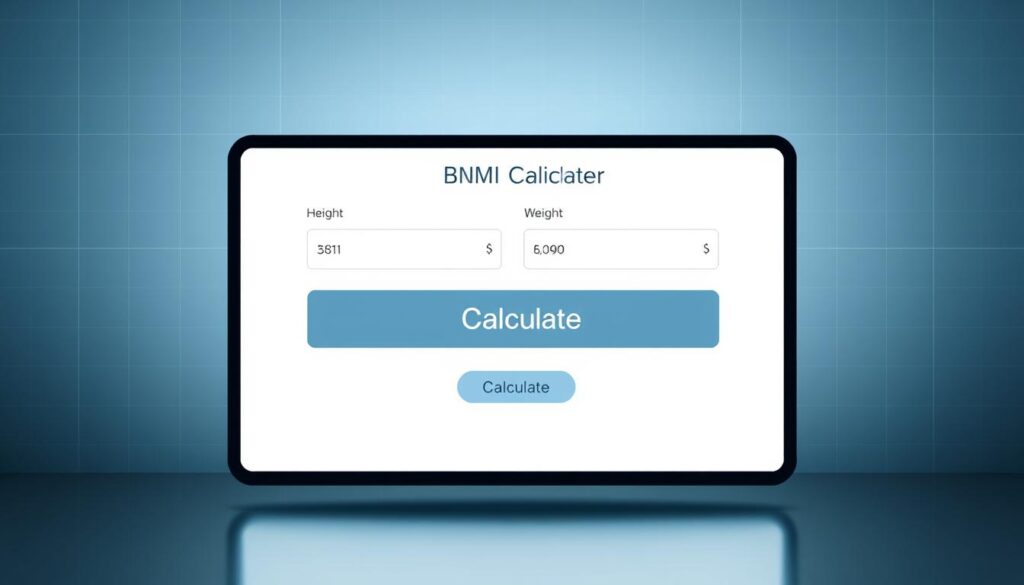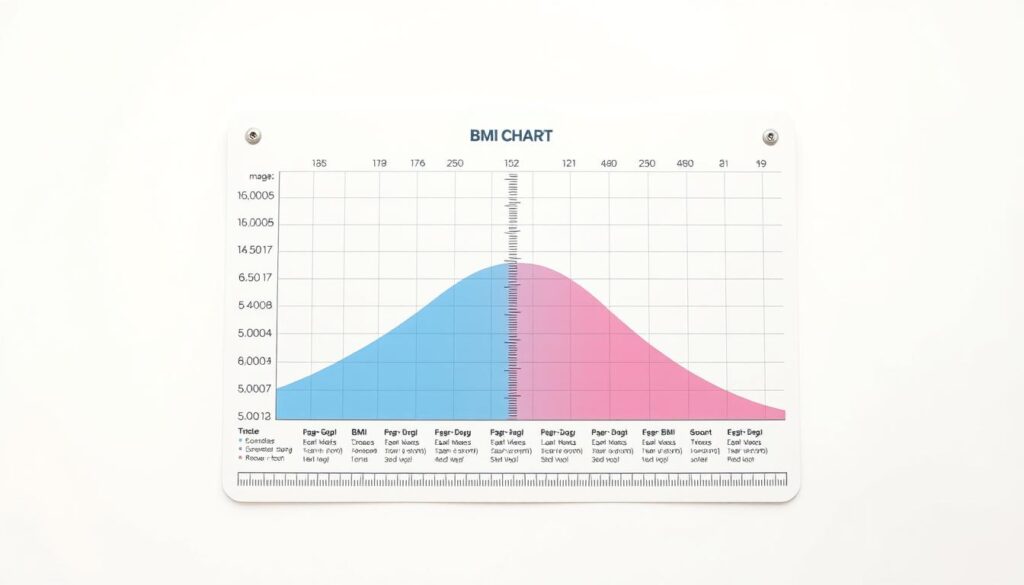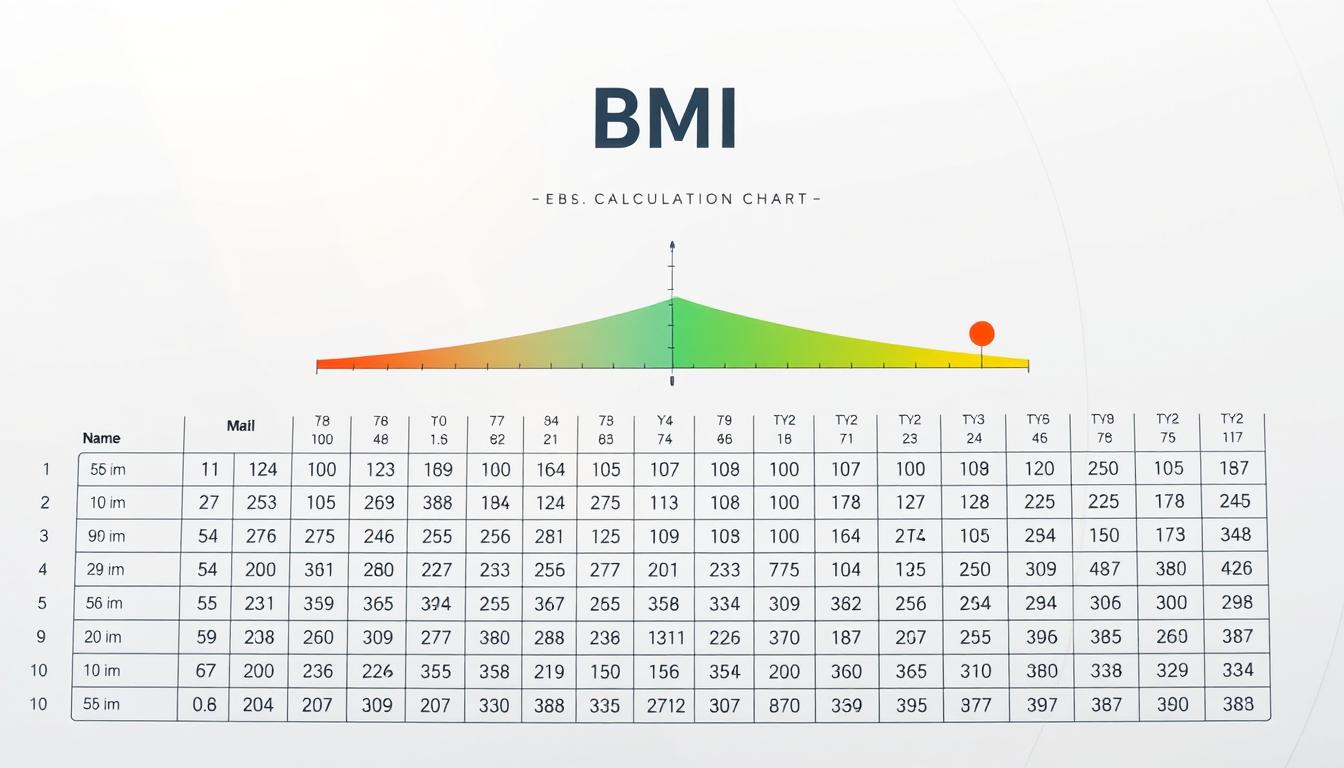Do you know your ideal weight? Or are you curious if your current weight is healthy for your height? Body Mass Index (BMI) is a common way to check if your weight is in a healthy range.
BMI calculation helps us see if you’re underweight, normal, overweight, or obese. It’s based on your height and weight. This makes it a simple yet effective tool for health assessment.
To calculate your BMI, you just need to know your weight and height. This info is key for understanding your health risks and setting achievable fitness goals.
Key Takeaways
- Understanding BMI helps assess health risks associated with weight.
- BMI is calculated using height and weight measurements.
- A healthy BMI range varies among different age groups and ethnicities.
- Knowing your BMI can help in setting realistic fitness goals.
- BMI is a general indicator and has its limitations.
What is BMI and Why Is It Important?
To understand BMI, we first need to know what it measures. Body Mass Index, or BMI, is a way to figure out if our weight is healthy based on our height and weight.
BMI is easy and works well. BMI is categorized into several groups: underweight, healthy weight, overweight, and obesity. These groups help doctors talk to patients about health risks linked to their weight.
Understanding Body Mass Index
BMI is found by dividing our weight in kilograms by our height in meters squared. Then, we use a BMI chart to see where we fall in the categories.
For adults, the World Health Organization has set BMI categories:
- Underweight: BMI
- Normal weight: BMI = 18.5-24.9
- Overweight: BMI = 25-29.9
- Obesity: BMI ≥ 30
Health Implications of BMI
Our BMI can affect our health a lot. Being too thin or too heavy can lead to health issues. For example, a high BMI can raise the risk of diseases like diabetes and heart disease.
| BMI Category | Health Risks |
|---|---|
| Underweight | Osteoporosis, hair loss, poor wound healing |
| Overweight/Obesity | Diabetes, heart disease, certain cancers |
Limitations of BMI as an Indicator
BMI is useful but has its downsides. It doesn’t directly measure body fat. Instead, it tells us if our weight is right for our height. This can lead to athletes being seen as overweight or obese, even if they’re not.
Even with its flaws, BMI is still a key tool for doctors. It’s simple and helps spot weight-related health problems.
How to Calculate BMI
Calculating your BMI is easy. It involves a simple formula. Knowing this helps you check your health and make better lifestyle choices.
Using the BMI Formula
The BMI formula is simple. You divide your weight in kilograms by your height in meters squared. It looks like this: BMI = kg/m2. For example, if you weigh 70 kg and are 1.75 meters tall, your BMI is 70 / (1.75)2 = 22.86.
Tools and Apps for BMI Calculation
Manual calculation is easy, but there are many online tools and apps to help. These BMI calculators online ask for your weight and height. They then calculate your BMI quickly. You can find web-based calculators and mobile apps to track your BMI over time.

Step-by-Step Calculation Process
To calculate your BMI manually, follow these steps:
- Measure your weight in kilograms.
- Measure your height in meters.
- Square your height (multiply it by itself).
- Divide your weight by the squared height.
For example, if your weight is 70 kg and height is 1.75 m, your BMI is 70 / (1.75 * 1.75) = 22.86.
Interpreting Your BMI Results
Knowing how to understand your BMI results is key to your health. After calculating your BMI, it’s important to know what it means. This knowledge helps you make better health choices.
BMI Categories Defined
The World Health Organization has set BMI categories. A BMI under 18.5 means you’re underweight. A BMI of 18.5 to 24.9 is normal. A BMI of 25 to 29.9 is overweight, and 30 or more is obese. Knowing these categories helps you understand your health risks.
Here’s a simple BMI chart to reference:
| BMI Category | BMI Range |
|---|---|
| Underweight | Less than 18.5 |
| Normal weight | 18.5 – 24.9 |
| Overweight | 25 – 29.9 |
| Obese | 30 or more |
What Should We Aim For?
It’s best to aim for a BMI between 18.5 and 24.9. This range is linked to lower health risks. An ideal weight calculator or BMI chart can show your ideal weight range based on your height.
To keep a healthy BMI, try these tips:
- Eat a balanced diet with lots of fruits, veggies, and whole grains.
- Stay active with activities like walking, cycling, or swimming.
- Keep an eye on your weight and adjust your lifestyle as needed.

Exceptions to Consider
While BMI is useful, it’s not perfect. Some people, like athletes with a lot of muscle, might have a high BMI without being overweight. It’s important to look at body composition and overall health too.
In conclusion, understanding your BMI is a big step in managing your health. Knowing your BMI category and aiming for a healthy weight can lower your health risks. It also improves your overall well-being.
The Role of Diet and Exercise in BMI
Keeping a healthy BMI needs a mix of good food and regular exercise. What we eat and do affects our BMI. Making smart choices can help us stay healthy and feel good.
Nutrition’s Impact on BMI
Eating right is key for a healthy BMI. The right amount of calories and nutrients helps control weight. Eating a variety of foods like fruits, veggies, whole grains, lean proteins, and healthy fats is important. Try to avoid too much of processed and high-calorie foods.
For more info on healthy eating, check out the National Institutes of Health. They offer lots of advice on nutrition and health.

The Importance of Physical Activity
Regular exercise is also vital for a healthy BMI. It burns calories and builds muscle, which helps with weight control. Aim for at least 150 minutes of moderate-intensity exercise or 75 minutes of vigorous-intensity exercise per week. Also, do muscle-strengthening activities on two or more days a week.
Tips for a Healthy Lifestyle
To keep a healthy BMI, adopt lasting lifestyle habits. Here are some tips:
- Keep track of your daily calorie intake and expenditure.
- Incorporate a variety of physical activities into your routine, such as walking, cycling, or swimming.
- Focus on whole, unprocessed foods rather than relying on packaged or fast food.
- Stay hydrated by drinking plenty of water throughout the day.
| Lifestyle Change | Impact on BMI |
|---|---|
| Increasing physical activity | Helps burn calories and build muscle, aiding in weight loss and management. |
| Eating a balanced diet | Provides essential nutrients and helps maintain a healthy weight. |
| Limiting processed foods | Reduces calorie intake and promotes healthier eating habits. |
Factors That Influence Our BMI
It’s important to know what affects our BMI. BMI, or Body Mass Index, helps us understand our weight status. But, it’s influenced by many things, so we need to think about these when we look at our BMI.
Genetics and BMI Correlation
Genetics have a big role in our body shape and BMI. Studies show that genes can affect how much we weigh and where we store fat. For example, some people might naturally store fat more easily, which can change their BMI.
As the Centers for Disease Control and Prevention (CDC) says, knowing about genetics can help us understand obesity and weight management. This is linked to BMI, which we can calculate using the BMI calculator metric.
Age and BMI Changes
Age also affects BMI. As we get older, our body fat percentage often goes up. This means older adults might face different health risks, even if their BMI is the same as a younger person’s. It’s key to think about age when looking at BMI’s health implications.
Using a BMI calculator online can help us see how BMI changes over time.
Gender Differences in BMI
Gender also matters when we talk about BMI. Women usually have more body fat than men for the same BMI. This is because men and women have different body compositions, with women having more fat and less muscle.
So, the health risks tied to a certain BMI can be different for men and women. Remember, “BMI is not a one-size-fits-all measure”.
In summary, BMI is a useful tool for checking weight status, but it’s influenced by genetics, age, and gender. By understanding these factors, we can better understand our BMI and work towards a healthier lifestyle.
Tracking Changes in Our BMI Over Time
Knowing how our BMI changes helps us make better health choices. By checking our BMI often, we spot patterns and trends that might not be clear at first.
Why Regular Monitoring Matters
It’s key to watch our BMI regularly. This helps us see how our weight changes over time. It’s great for those trying to lose or keep off weight.
Early Detection of Health Risks: Watching our BMI can also spot health risks early. For example, a sudden BMI increase might mean we need to check our health.
Tools for Tracking BMI Changes
There are many ways to track BMI changes. Here are a few:
- Mobile apps for health and fitness tracking
- Spreadsheets or digital journals for logging weight and height
- Online health platforms with BMI tracking
These tools help us keep a record of our BMI. This makes it easier to see trends and adjust our lifestyle.
| Tool | Description | Features |
|---|---|---|
| Mobile Apps | Apps like MyFitnessPal and Lose It! track weight and BMI. | Weight tracking, calorie counting, exercise logging |
| Spreadsheets | Digital spreadsheets can create custom BMI charts. | Customizable, data analysis, chart creation |
| Online Health Platforms | Websites like Fitbit and MyNetDiary track BMI and more. | BMI tracking, weight history, health insights |
Setting Realistic Goals
When tracking BMI, setting realistic goals is important. Remember, BMI is just one health measure. Changes should be slow and lasting.
Consulting Healthcare Professionals: For advice on health goals and BMI changes, talk to health experts. They offer personalized advice based on your health needs.
Resources for Further Information on BMI
Looking for more on BMI and health? Many reliable sources are out there. You can use online tools, like the BMI calculator, to figure out your BMI and what it means.
Trusted Websites and Organizations
Government sites, like the Centers for Disease Control and Prevention (CDC), give solid advice on BMI. They explain what underweight, normal, overweight, and obese mean. These places help us understand how to find and read our BMI.
Books and Articles on Nutrition and Health
Health organizations and publications share important info on nutrition and health. By checking these out, we learn how diet and exercise affect our BMI and health.
Community Programs and Support Groups
Community programs and support groups offer help and encouragement for a healthy BMI. Using these resources, we can better understand how to live a balanced life and make smart health choices.


